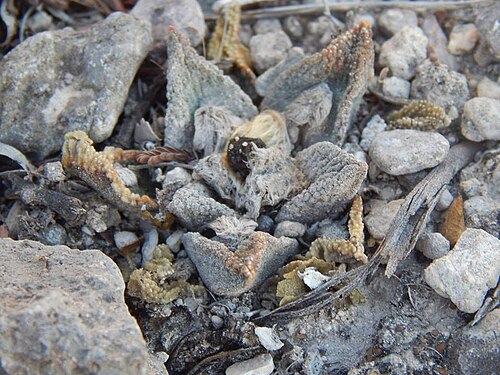Ariocarpus bravoanus
| Ariocarpus bravoanus | |
|---|---|
 | |
Conservation status | |
CITES Appendix I (CITES)[2] | |
| Scientific classification | |
| Kingdom: | Plantae |
| Clade: | Tracheophytes |
| Clade: | Angiosperms |
| Clade: | Eudicots |
| Order: | Caryophyllales |
| Family: | Cactaceae |
| Subfamily: | Cactoideae |
| Genus: | Ariocarpus |
| Species: | A. bravoanus |
| Binomial name | |
| Ariocarpus bravoanus H.M.Hern. & E.F.Anderson | |
| Synonyms | |
| |
Ariocarpus bravoanus is a species of cactus which is endemic to San Luis Potosí in Mexico. It grows in dry shrubland habitat on limestone substrates. It is endangered due to overcollecting.[1]
Description
Ariocarpus bravoanus is a fleshy plant grows geophytically with gray-green bodies that are 3 to 9 centimeters in diameter and that barely protrude from the soil surface. The flattened, triangular and somewhat pointed warts protrude only slightly from the base of the shoot. The variable areoles sometimes have a woolly furrow along the entire length of the mastoid or are formed as a woolly cushion near the tip of the mastoid.
The magenta-colored flowers reach a diameter of 2.5 to 5 centimeters. The mostly light brown fruits are inconspicuous.[3]
Subspecies
As of 2023[update], Plants of the World Online accepted two varieties:[4]
| Image | Subspecies | Distribution |
|---|---|---|
 | Ariocarpus bravoanus subsp. bravoanus | Mexico (San Luis Potosí) |
 | Ariocarpus bravoanus subsp. hintonii (Stuppy & N.P.Taylor) E.F.Anderson & W.A.Fitz Maur. | Mexico (N. San Luis Potosí). |
Distribution
Ariocarpus bravoanus is found growing on xerophytic shrubland on a limestone gravel plains in the Mexican state of San Luis Potosí at elevations between 1500 to 2000 meters. and is only known from a few localities. The habitat is fragmented.[5]
-
 Plant of Ariocarpus bravoanus subsp. bravoanus growing in habitat near Núñez, San Luis Potosi
Plant of Ariocarpus bravoanus subsp. bravoanus growing in habitat near Núñez, San Luis Potosi
Taxonomy
The first description was made in 1992 by Héctor Manuel Hernández and Edward Frederick Anderson.The plant was discovered while removing soil for the collection of another herbarium specimen.[5] The specific epithet "bravoanus" honors the Mexican botanist and cactus collector Helia Bravo Hollis. Nomenclature synonyms are Ariocarpus kotschoubeyanus subsp. bravoanus (H.M.Hern. & E.F.Anderson) Halda (1998) and Ariocarpus fissuratus subsp. bravoanus (H.M.Hern. & E.F.Anderson) Lüthy (1999).
References
- ^ a b Sotomayor, M.; Fitz Maurice, B.; Gómez-Hinostrosa, C.; Fitz Maurice, W.A.; Smith, M.; Hernández, H.M. (2013). "Ariocarpus bravoanus". IUCN Red List of Threatened Species. 2013: e.T40957A2947027. doi:10.2305/IUCN.UK.2013-1.RLTS.T40957A2947027.en. Retrieved 16 November 2021.
- ^ "Appendices | CITES". cites.org. Retrieved 2022-01-14.
- ^ Anderson, Edward F.; Eggli, Urs (2005). Das grosse Kakteen-Lexikon (in German). Stuttgart (Hohenheim): Ulmer. p. 72. ISBN 3-8001-4573-1.
- ^ "Ariocarpus bravoanus H.M.Hern. & E.F.Anderson". Plants of the World Online. Retrieved 2023-10-22.
- ^ a b "Ariocarpus bravoanus". LLIFLE. 2013-08-04. Retrieved 2024-06-15.
External links
 Media related to Ariocarpus bravoanus at Wikimedia Commons
Media related to Ariocarpus bravoanus at Wikimedia Commons Data related to Ariocarpus bravoanus at Wikispecies
Data related to Ariocarpus bravoanus at Wikispecies
















